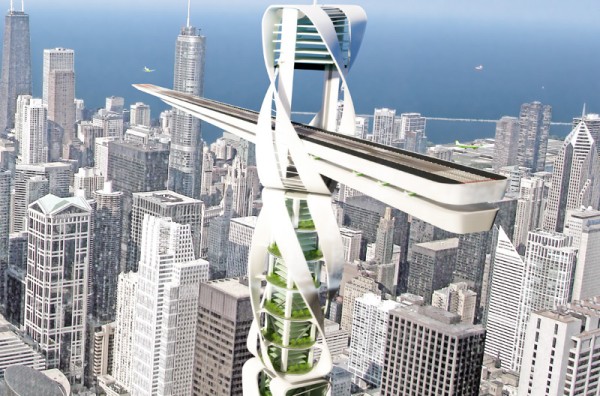Honorable Mention
2012 Skyscraper Competition
Gerasimos Pavlidis
Greece
Inspired by the towering cranes found in big cities, the 380 meter-tall GreenGru skyscraper provides public transportation via air to residents of metropolises with traffic problems or airports located far from the core. It also works as an energy station, generating enough power from within to run its own systems and light up some of the surrounding city as well.
The building’s name capitalizes on the energy creation inside, a process the designer’s have dubbed “Artificial Photosynthesis Installation,” explaining the “green.” “Gru” is the Italian translation of “tower crane,” the basis of its look.
The tower’s mast is made of carbon-nanotube-reinforced steel, with large concrete counterweights underground for stabilization. The building’s façade, inspired by twisted rubber bands, is made of graphite, which is ten times stronger and six times lighter than steel. The graphite is covered in a polymeric carbon dioxide-absorber called zeolight, which lowers carbon dioxide levels during the night; sunlight exposure during the day allows the molecules to float away. This means the exterior of the building creates a greenhouse effect inside, making the environment excellent for growing plants.
The ground level and first five floors of the skyscraper are reserved for commercial use; the 80 floors above that hold offices and residential units. Above that, the upper portion of the building has a high-speed turbine that spins around the building to generate power. Its exterior is clad in flexible and lightweight polymer-based solar cells for further energy generation. Inside, the mechanical systems take neutral water and separate its molecules, storing the hydrogen and oxygen cells separately to produce useable energy in a process that harkens to photosynthesis. It is the stored hydrogen and the power it is able to produce that is responsible for energizing the building; it is also stored and transported in cells made of magnesium nanoparticles and polymethyl methacrylate to other parts of the city for use as energy elsewhere.
Atop the building is a downtown airport from which fully automated, hydrogen-electric hybrid aircrafts fly in and out. The aircrafts obtain hydrogen fuel from the processes capturing hydrogen within the building. An ultra-light truss structure supports a 300 meter-long runway, which is made of carbon-nanotubes and rotates with the wind. An aircraft-elevator inside the counter jib moves the aircrafts from and to the hangar.

















